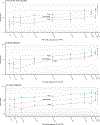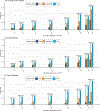Interactions Between Enhanced Polygenic Risk Scores and Lifestyle for Cardiovascular Disease, Diabetes, and Lipid Levels
- PMID: 33433237
- PMCID: PMC7887077
- DOI: 10.1161/CIRCGEN.120.003128
Interactions Between Enhanced Polygenic Risk Scores and Lifestyle for Cardiovascular Disease, Diabetes, and Lipid Levels
Abstract
Background: Both lifestyle and genetic factors confer risk for cardiovascular diseases, type 2 diabetes, and dyslipidemia. However, the interactions between these 2 groups of risk factors were not comprehensively understood due to previous poor estimation of genetic risk. Here we set out to develop enhanced polygenic risk scores (PRS) and systematically investigate multiplicative and additive interactions between PRS and lifestyle for coronary artery disease, atrial fibrillation, type 2 diabetes, total cholesterol, triglyceride, and LDL-cholesterol.
Methods: Our study included 276 096 unrelated White British participants from the UK Biobank. We investigated several PRS methods (P+T, LDpred, PRS continuous shrinkage, and AnnoPred) and showed that AnnoPred achieved consistently improved prediction accuracy for all 6 diseases/traits. With enhanced PRS and combined lifestyle status categorized by smoking, body mass index, physical activity, and diet, we investigated both multiplicative and additive interactions between PRS and lifestyle using regression models.
Results: We observed that healthy lifestyle reduced disease incidence by similar multiplicative magnitude across different PRS groups. The absolute risk reduction from lifestyle adherence was, however, significantly greater in individuals with higher PRS. Specifically, for type 2 diabetes, the absolute risk reduction from lifestyle adherence was 12.4% (95% CI, 10.0%-14.9%) in the top 1% PRS versus 2.8% (95% CI, 2.3%-3.3%) in the bottom PRS decile, leading to a ratio of >4.4. We also observed a significant interaction effect between PRS and lifestyle on triglyceride level.
Conclusions: By leveraging functional annotations, AnnoPred outperforms state-of-the-art methods on quantifying genetic risk through PRS. Our analyses based on enhanced PRS suggest that individuals with high genetic risk may derive similar relative but greater absolute benefit from lifestyle adherence.
Keywords: atrial fibrillation; cardiovascular disease; coronary artery disease; healthy lifestyle; triglycerides.
Figures




Similar articles
-
Associations of Combined Genetic and Lifestyle Risks With Incident Cardiovascular Disease and Diabetes in the UK Biobank Study.JAMA Cardiol. 2018 Aug 1;3(8):693-702. doi: 10.1001/jamacardio.2018.1717. JAMA Cardiol. 2018. PMID: 29955826 Free PMC article.
-
Educational attainment as a modifier for the effect of polygenic scores for cardiovascular risk factors: cross-sectional and prospective analysis of UK Biobank.Int J Epidemiol. 2022 Jun 13;51(3):885-897. doi: 10.1093/ije/dyac002. Int J Epidemiol. 2022. PMID: 35134953 Free PMC article.
-
Association of healthy lifestyle factors and genetic liability with bipolar disorder: Findings from the UK Biobank.J Affect Disord. 2024 Nov 1;364:279-285. doi: 10.1016/j.jad.2024.08.011. Epub 2024 Aug 12. J Affect Disord. 2024. PMID: 39137837
-
Polygenic risk for type 2 diabetes, lifestyle, metabolic health, and cardiovascular disease: a prospective UK Biobank study.Cardiovasc Diabetol. 2022 Jul 14;21(1):131. doi: 10.1186/s12933-022-01560-2. Cardiovasc Diabetol. 2022. PMID: 35836215 Free PMC article.
-
Towards clinical utility of polygenic risk scores.Hum Mol Genet. 2019 Nov 21;28(R2):R133-R142. doi: 10.1093/hmg/ddz187. Hum Mol Genet. 2019. PMID: 31363735 Review.
Cited by
-
Population Heterogeneity and Selection of Coronary Artery Disease Polygenic Scores.J Pers Med. 2024 Sep 26;14(10):1025. doi: 10.3390/jpm14101025. J Pers Med. 2024. PMID: 39452533 Free PMC article.
-
Validating and automating learning of cardiometabolic polygenic risk scores from direct-to-consumer genetic and phenotypic data: implications for scaling precision health research.Hum Genomics. 2022 Sep 8;16(1):37. doi: 10.1186/s40246-022-00406-y. Hum Genomics. 2022. PMID: 36076307 Free PMC article.
-
Association of the Interaction Between Familial Hypercholesterolemia Variants and Adherence to a Healthy Lifestyle With Risk of Coronary Artery Disease.JAMA Netw Open. 2022 Mar 1;5(3):e222687. doi: 10.1001/jamanetworkopen.2022.2687. JAMA Netw Open. 2022. PMID: 35294538 Free PMC article.
-
Meta-prediction of coronary artery disease risk.Nat Med. 2025 Jul;31(7):2277-2288. doi: 10.1038/s41591-025-03648-0. Epub 2025 Apr 16. Nat Med. 2025. PMID: 40240837
-
Favourable Lifestyle Protects Cognitive Function in Older Adults With High Genetic Risk of Obesity: A Prospective Cohort Study.Front Mol Neurosci. 2022 May 23;15:808209. doi: 10.3389/fnmol.2022.808209. eCollection 2022. Front Mol Neurosci. 2022. PMID: 35677584 Free PMC article.
References
-
- Benjamin EJ, Muntner P, Alonso A, Bittencourt MS, Callaway CW, Carson AP, Chamberlain AM, Chang AR, Cheng S, Das SR, et al., American Heart Association Council on Epidemiology and Prevention Statistics Committee and Stroke Statistics Subcommittee. Heart Disease and Stroke Statistics-2019 Update: A Report From the American Heart Association. Circulation. 2019;139:e56–e528. - PubMed
-
- Arnett DK, Blumenthal RS, Albert MA, Buroker AB, Goldberger ZD, Hahn EJ, Himmelfarb CD, Khera A, Lloyd-Jones D, McEvoy JW, et al. 2019 ACC/AHA Guideline on the Primary Prevention of Cardiovascular Disease: A Report of the American College of Cardiology/American Heart Association Task Force on Clinical Practice Guidelines. Circulation. 2019;140:e596–e646. - PMC - PubMed
Publication types
MeSH terms
Substances
Grants and funding
LinkOut - more resources
Full Text Sources
Other Literature Sources
Medical

